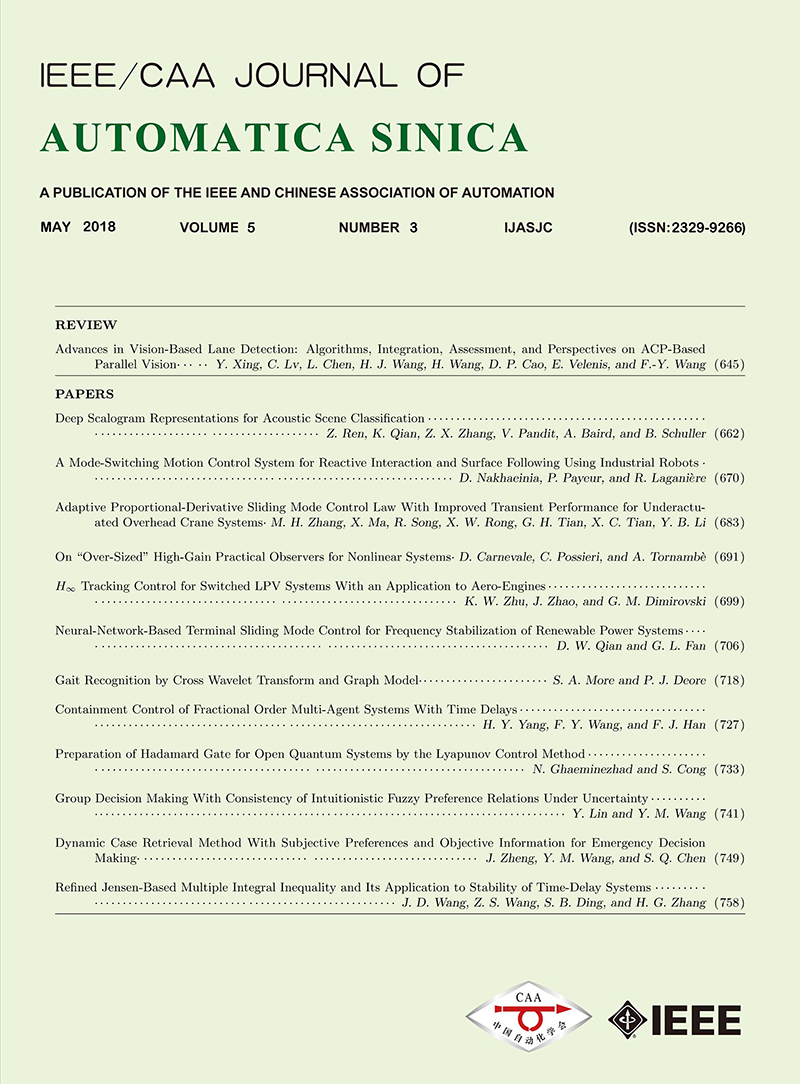 Volume 2
Issue 4
Volume 2
Issue 4
IEEE/CAA Journal of Automatica Sinica
| Citation: | Shengxiang Gao, Zhengtao Yu, Linbin Shi, Xin Yan and Haixia Song, "Review Expert Collaborative Recommendation Algorithm Based on Topic Relationship," IEEE/CAA J. of Autom. Sinica, vol. 2, no. 4, pp. 403-411, 2015. |

| [1] |
Adomavicius G, Tuzhilin A. Toward the next generation of recommender systems: a survey of the state-of-the-art and possible extensions. IEEE Transactions on Knowledge and Data Engineering, 2005, 17(6): 734-749
|
| [2] |
Herlocker J L, Konstan J A, Borchers A, Riedl J. An algorithmic framework for performing collaborative filtering. In: Proceedings of the 22nd Annual International ACM SIGIR Conference on Research and Development in Information Retrieval, SIGIR'99. New York, NY, USA: ACM, 1999. 230-237
|
| [3] |
Sarwar B, Karypis G, Konstan J, Riedl J. Item-based collaborative filtering recommendation algorithms. In: Proceedings of the 10th International Conference on World Wide Web, WWW'01. New York, NY, USA: ACM, 2001. 285-295
|
| [4] |
Ungar L H, Foster D P. Clustering methods for collaborative filtering. In: Proceedings of the 1998 Workshop on Recommender Systems. Menlo Park: AAAI, 1998. 114-129
|
| [5] |
Getoor L, Sahami M. Using probabilistic relational models for collaborative filtering. In: Proceedings of the 1999 Workshop on Web Usage Analysis and User Profiling. San Diego: Springer-Verlag, 1999. 83-96
|
| [6] |
Chien Y H, George E I. A Bayesian model for collaborative filtering. In: Proceedings of the 7th International Workshop on Artificial Intelligence and Statistics. San Francsico, CA: Morgan Kaufmann, 1999. 187-192
|
| [7] |
Hofmann T. Collaborative filtering via Gaussian probabilistic latent semantic analysis. In: Proceedings of the 26th Annual International ACM SIGIR Conference on Research and Development in Information Retrieval, SIGIR'03. New York, NY, USA: ACM, 2003. 259-266
|
| [8] |
Sarwar B M, Karypis G, Konstan J A, Riedl J. Application of dimensionality reduction in recommender system — a case study. In: Proceedings of the 2000 ACM-SIGKDD Conference on Knowledge Discovery in Databases, Web Mining For E-Commerce Workshop, WEBKDD'2000. Boston, MA, USA: ACM, 2000. 1-12
|
| [9] |
Hofmann T. Latent semantic models for collaborative filtering. ACM Transactions on Information Systems, 2004, 22(1): 89-115
|
| [10] |
Koren Y, Bell R, Volinsky C. Matrix factorization techniques for recommender systems. IEEE Computer, 2009, 42(8): 30-37
|
| [11] |
Salakhutdinov R, Mnih A. Probabilistic matrix factorization. In: Proceedings of the 2007 Conference on Advances in Neural Information Processing Systems 20. Vancouver, BC, CA: Curran Associates Inc., 2007. 1257-1264
|
| [12] |
Takács G, Pilászy I, Németh B, Tikk D. Matrix factorization and neighbor based algorithms for the netflix prize problem. In: Proceedings of the 2008 ACM Conference on Recommender Systems. New York, NY, USA: Association for Computing Machinery, 2008. 267-274
|
| [13] |
Zhen Y, Li W J, Yeung D Y. Tagicofi: tag informed collaborative filtering. In: Proceedings of the 3rd ACM Conference on Recommender Systems. New York, NY, USA: Association for Computing Machinery, 2009. 69-76
|
| [14] |
Zhou T C, Ma H, King I, Lyu M R. Tagrec: leveraging tagging wisdom for recommendation. In: Proceedings of the 12th IEEE International Conference on Computational Science and Engineering, CSE 2009. Vancouver, BC, CA: IEEE Computer Society, 2009. 194-199
|
| [15] |
Ma H, Yang H X, Lyu M R, King I. SoRec: social recommendation using probabilistic matrix factorization. In: Proceedings of the 17th ACM Conference on Information and Knowledge Management, CIKM'08. New York, NY, USA: ACM, 2008. 978-991
|
| [16] |
Ma H, King I, Lyu M R. Learning to recommend with social trust ensemble. In: Proceedings of the 32nd International ACM SIGIR Conference on Research and Development in Information Retrieval, SIGIR'09. New York, NY, USA: ACM, 2009. 203-210
|
| [17] |
Jamali M, Ester M. TrustWalker: a random walk model for combining trust-based and item-based recommendation. In: Proceedings of the 15th ACM SIGKDD International Conference on Knowledge Discovery and Data Mining, KDD'09. New York, NY, USA: ACM, 2009. 397-406
|
| [18] |
Guo L, Ma J, Chen Z M, Jiang H R. Learning to recommend with social relation ensemble. In: Proceedings of the 21st ACM International Conference on Information and Knowledge Management, CIKM'12. New York, NY, USA: ACM, 2012. 2599-2602
|
| [19] |
Wu L, Chen E H, Liu Q, Xu L L, Bao T F, Zhang L. Leveraging tagging for neighborhood-aware probabilistic matrix factorization. In: Proceedings of the 21st ACM International Conference on Information and Knowledge Management, CIKM'12. New York, NY, USA: ACM, 2012. 1854-1858
|
| [20] |
Blei D M, Ng A, Jordan M. Latent Dirichlet allocation. Journal of Machine Learning Research, 2003, 3(1): 993-1022
|
| [21] |
Zhang Y M. Research on Expert-level Network Relationships Construction Integrating Explicit and Implicit Relationships [Master dissertation], Kunming University of Science and Technology, China, 2013.
|
| [22] |
Tian W, Shen T, Yu Z T, Guo J Y, Xian Y T. A Chinese expert name disambiguation approach based on spectral clustering with the expert page-associated relationships. In: Proceedings of the 2013 Chinese Intelligent Automation Conference. Yangzhou, JS, China: Springer, 2013. 245-253
|
| [23] |
Jamali M, Ester M. A matrix factorization technique with trust propagation for recommendation in social networks. In: Proceedings of the 4th ACM Conference on Recommender Systems. New York, NY, USA: ACM, 2010. 135-142
|
| [24] |
Koren Y. Factorization meets the neighborhood: a multifaceted collaborative filtering model. In: Proceedings of the 14th ACM SIGKDD International Conference on Knowledge Discovery and Data Mining, KDD'08. New York, NY, USA: ACM, 2008. 426-434
|